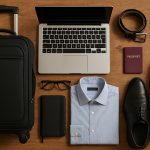Long-haul flights disrupt sleep schedules, drain energy, and make it harder to stay sharp for meetings. Adjusting quickly is possible with the right approach. Proper timing, strategic light exposure, and a few simple habits can minimize fatigue and keep performance at its best.
1. Plan Your Sleep Before Departure
Adjust Your Sleep Schedule
- Gradually shift bedtime closer to the destination’s time zone a few days before departure.
- Move in increments of 30–60 minutes each night to ease the transition.
Use Sleep Aids Wisely
- Melatonin can help reset the body’s internal clock. Take it when it’s nighttime at your destination.
- Avoid caffeine and alcohol before bed to prevent sleep disruptions.
Optimize Your Sleep Environment
- Blackout curtains or sleep masks help regulate melatonin production.
- White noise apps or earplugs block out disturbances.
2. Stay Hydrated and Eat Smart
Water First, Caffeine Second
- Dehydration worsens fatigue and jet lag symptoms. Drink water consistently before, during, and after the flight.
- If caffeine is needed, use it strategically. Have it in the morning at the destination, not before bedtime.
Eat According to Destination Time
- Align meals with local time as soon as possible.
- Choose protein-rich breakfasts and lighter dinners to support natural energy cycles.
3. Control Light Exposure for Faster Adaptation
Light resets the body clock more than anything else. Use it strategically:
Increase Exposure to Natural Light
- Spend time outdoors upon arrival to sync with the new time zone.
- Morning light is best when traveling east, while evening light helps when traveling west.
Avoid Screens Before Bed
- Blue light from devices can delay sleep by suppressing melatonin.
- Use blue light filters if work requires screen time at night.
4. Time Naps and Sleep for Maximum Recovery
Short Naps Over Long Sleep
- A 20-minute nap can provide a boost without grogginess.
- Avoid naps longer than 90 minutes, as they can make adjusting harder.
Align Sleep with Local Nighttime
- Even if tired, stay awake until bedtime at the destination.
- If a nap is unavoidable, keep it short and before 3 p.m. local time.
5. Move to Stay Alert and Prevent Fatigue
Exercise Before and After the Flight
- Light movement before takeoff helps circulation.
- Stretching and short walks during layovers prevent stiffness.
Use Simple In-Flight Exercises
- Ankle rolls and seated leg lifts reduce swelling.
- Shoulder rolls ease upper body tension.
6. Use Travel Hacks to Improve Sleep and Energy
Book Flights That Support Adjustment
- Red-eye flights can work well if they land in the morning and allow a full day to adjust.
- If possible, arrive a day early for an extra buffer before meetings.
Use the Right Travel Accessories
- A neck pillow and noise-canceling headphones improve rest during the flight.
- Compression socks reduce swelling and improve circulation.
7. Stick to a Routine for Long-Term Travel Success
Follow a Consistent Wake-Up Time
- Keeping a regular schedule helps adjust faster.
- Even after returning home, avoid drastic shifts in sleep timing.
Maintain Energy Without Overloading on Stimulants
- Green tea or matcha can provide a gentler caffeine boost than coffee.
- Staying active with light movement every hour prevents sluggishness.
Jet lag doesn’t have to derail productivity. A few adjustments before, during, and after the trip can make all the difference. The key is syncing with the new time zone as quickly as possible while giving the body the support it needs.



